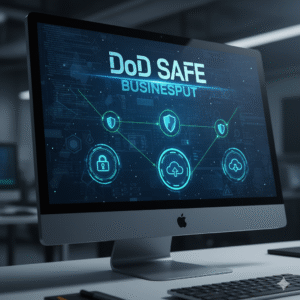🔒 DoD SAFE: The Technology Keeping Defense File Transfers Secure
The U.S. Department of Defense (DoD) cannot risk compromising security when it comes to transmitting sensitive information in the world that data security is not a bargaining point.
That is where DoD SAFE Secure Access File Exchange comes in. It could be that you are a defense contractor, a government employee or an outsourcing partner, but with DoD SAFE, it is possible to send and receive large files securely, without the security risk of unsecured cloud storage and email systems.
Now we can discuss how this potent platform works, why it is so great and how you can use it. What Is DoD SAFE? SAFE (Secure Access File Exchange) is a web-based secure file-sharing service that was created by the Defense Information Systems Agency (DISA). It enables DoD staff and authorized third parties to share files up to 8 GB – encrypted, tracked and automatically erased after a short period.
DOD SAFE was originally created to compensate outdated systems such as AMRDEC SAFE to ensure the transfer of information (even unclassified sensitive information such as CUI, PII, or PHI) with full protection. Imagine DoD version of Google Drive or WeTransfer, which has been designed to be as secure and complaint as possible instead of convenient.
💻 How to Use DoD SAFE (Step-by-Step)
Here’s how simple it is to use DoD SAFE:
-
Go to the portal → https://safe.apps.mil
-
Authenticate → DoD users use their CAC card; guests follow the invitation link.
-
Upload your files → Choose up to 25 files (total ≤ 8 GB).
-
Add recipient info → Enter their email address.
-
Select encryption → Always choose “Encrypt files at rest.”
-
Send → Once uploaded, the recipient gets a download link and access code via email.
-
File pickup → Recipient downloads within 7 days.
💡 Pro tip: For very large files, compress them into a single ZIP before uploading.

🧠 Security and Compliance
DoD SAFE isn’t just a convenience — it’s a compliance requirement woven into the daily digital operations of the U.S. Department of Defense. It helps meet strict cybersecurity standards and protects sensitive government and contractor information from unauthorized access or leaks.
Here’s how it aligns with the key frameworks that govern defense cybersecurity:
🧾 NIST SP 800-171: Protecting Controlled Unclassified Information (CUI)
The National Institute of Standards and Technology (NIST) SP 800-171 sets the benchmark for how organizations must protect Controlled Unclassified Information (CUI) when stored, transmitted, or processed outside federal systems.
DoD SAFE directly supports these requirements by ensuring that:
-
All data transfers are encrypted in transit and at rest 🔐
Files are automatically deleted after a short retention period to minimize data exposure risk
-
Access is restricted only to verified DoD or approved external users
This ensures that contractors and agencies using DoD SAFE remain compliant with federal data-handling standards.
🧰 DoD Cybersecurity Framework: Zero Trust & Defense-in-Depth
The Department of Defense’s cybersecurity model is built around Zero Trust Architecture — meaning no user or device is trusted by default.
DoD SAFE reflects this principle by requiring identity verification (CAC authentication), controlled guest access, and limited file lifespans.
Additionally, it contributes to the Defense-in-Depth strategy by layering protection — combining encryption, auditing, user authentication, and automatic deletion to reduce potential attack surfaces. 🛡️
This multi-layered security makes DoD SAFE an essential part of the DoD’s overall digital defense ecosystem.
🔍 Audit Trails: Accountability and Traceability
Every single action on DoD SAFE — whether it’s an upload, download, or deletion — is logged and timestamped for review.
This means that if a security incident or data breach is suspected, investigators can trace the activity trail to identify when, where, and by whom the file was accessed.
These audit logs also serve as compliance proof during internal or external cybersecurity audits, ensuring transparency and accountability in every transaction.
📊 In essence, nothing slips through unnoticed — every action is recorded for full traceability.
⚖️ Authority to Operate (ATO): Certified and Trusted
DoD SAFE has received an Authority to Operate (ATO) — a formal certification granted only after the system meets rigorous DoD cybersecurity and risk management requirements.
This means the platform has undergone extensive security testing, vulnerability assessments, and compliance evaluations before being approved for operational use.
The ATO not only confirms the platform’s reliability but also assures users that DoD SAFE meets the highest federal security standards for handling sensitive defense-related information. ✅
🔄 Alternatives and When to Use Them
Sometimes, DoD SAFE may not fit every workflow. For example:
-
You need to transfer files larger than 8 GB.
-
You require real-time collaboration (DoD SAFE is for one-way transfers).
-
You’re operating outside DoD environments.
In those cases, approved secure platforms like DISA’s milCloud, encrypted email gateways, or FedRAMP-compliant storage systems (e.g., Microsoft Azure Gov, AWS GovCloud) may be better suited — as long as they meet DoD compliance standards.
🧭 Best Practices for Safe File Sharing
To get the most from DoD SAFE and stay compliant, follow these golden rules:
✅ Always encrypt at rest when sending any PII, PHI, or CUI.
✅ Use ZIP compression for big or multiple files.
✅ Notify recipients promptly — remember the 7-day limit.
✅ Avoid public Wi-Fi during uploads/downloads.
✅ Keep logs of who you sent files to and when.
✅ Test smaller transfers first to confirm system access.
💬 Security is everyone’s responsibility — the system is only as secure as its users.
🔮 The Future of DoD SAFE and Secure File Exchange
As cyber threats grow more sophisticated, DoD’s file-transfer systems are expected to evolve. Future versions of DoD SAFE or its successors might include:
-
📈 Higher file size limits
-
🔄 Better integration with DoD cloud environments
-
🧱 Stronger Zero-Trust security layers
-
🌐 Improved user experience and mobile compatibility
The next generation of secure collaboration will likely blend DoD SAFE-style security with cloud agility — ensuring military-grade data protection even in remote or hybrid work settings.

🏁 Conclusion
DoD SAFE proves that security and simplicity can coexist. It’s a trusted, time-tested platform for keeping sensitive DoD data protected — whether you’re sending one document or a 7 GB technical blueprint.
By following encryption best practices and respecting its limits, users can share information confidently, knowing they’re supporting the mission of secure defense communication. If your organization works with the DoD, understanding and correctly using DoD SAFE isn’t optional — it’s essential.
So next time you need to send a critical file, skip the risky email attachment. Log into DoD SAFE, encrypt your data, and transfer it the smart, secure way. 🔐✨DoD SAFE continues to be a critical piece of cybersecurity infrastructure for America’s defense operations. By using it correctly — encrypting data, respecting limits, and following access rules — you help ensure sensitive information stays protected from digital threats.
💬 Frequently Asked Questions (FAQ)
❓1. What does “DoD SAFE” stand for?
DoD SAFE stands for Department of Defense Secure Access File Exchange. It’s a web-based platform used to securely send and receive large files between DoD employees, military members, contractors, and approved external users.
❓2. Can I use DoD SAFE without a CAC card?
Yes — external or guest users can use DoD SAFE without a CAC card. However, they can only access the system if invited by an authorized DoD employee or contractor. The invitation email contains a one-time access link and passcode.
❓3. How do I log in to DoD SAFE?
1️⃣ Visit the official site 👉 https://safe.apps.mil
2️⃣ Choose whether you’re a CAC user (DoD personnel) or a guest.
3️⃣ CAC users log in with their Common Access Card or DoD certificate.
4️⃣ Guest users follow the invitation link and enter the passcode provided in their email.
Once logged in, users can upload, download, or track secure file transfers.
❓4. What is the full meaning of DoD?
DoD stands for the United States Department of Defense — the federal agency responsible for coordinating and supervising all agencies and functions of the government relating directly to national security and the Armed Forces. 🇺🇸
❓5. Is DoD SAFE only for government use?
Primarily, yes. ⚙️
DoD SAFE is designed for DoD employees, military members, and approved contractors or partners. External users can only access the system through a guest invitation from an authorized DoD sender — making it tightly controlled for security reasons.
❓6. Is DoD SAFE available on mobile?
While you can access DoD SAFE using a mobile browser, it’s optimized for desktop use.
Large file uploads or CAC-based logins often require desktop access because most mobile devices don’t support CAC card readers or DoD certificates natively.
❓7. Is DoD SAFE legitimate?
Absolutely ✅
DoD SAFE is an official Department of Defense platform managed by the Defense Information Systems Agency (DISA).
Its official domain is safe.apps.mil — any other website claiming to be DoD SAFE may be fraudulent. Always check the “.mil” domain to confirm authenticity.
❓8. How do I get a DoD SAFE request code?
When a DoD user invites you to send or receive a file, you’ll receive an email from DoD SAFE containing:
-
A Drop-off Request Code or Passcode
-
A unique link to upload or download your file
Without this invitation, you cannot access the system. If you haven’t received one, contact the DoD sender directly.
❓9. Where can I find my DoD ID number?
If you’re a DoD member, your DoD ID number is printed on the back of your Common Access Card (CAC), just below the barcode.
You can also find it in your milConnect account or your personnel profile under DoD Human Resources systems.




